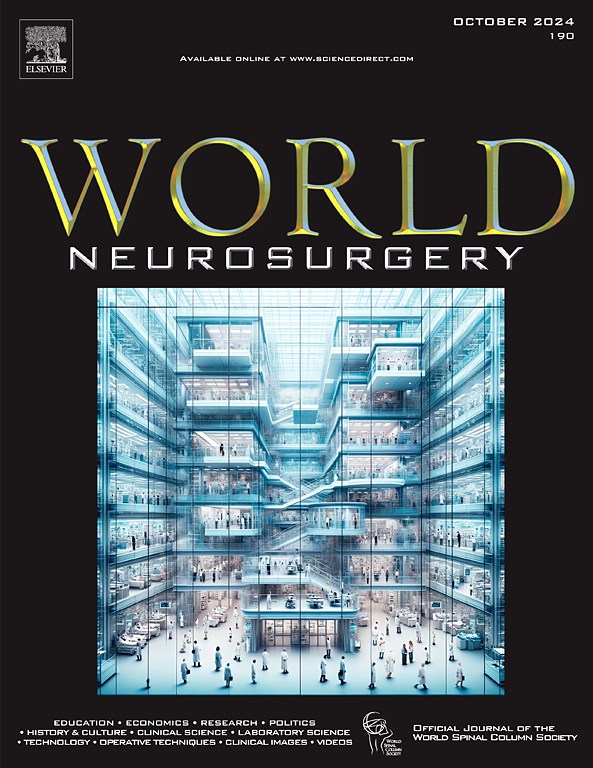三叉微血管减压治疗难治性短期单侧神经痛性头痛:单中心回顾性分析
IF 2.1
4区 医学
Q3 CLINICAL NEUROLOGY
引用次数: 0
摘要
目的:本分析旨在评估三叉神经血管冲突(NVC)与疼痛侧同侧的难治性短时间单侧神经性头痛(SUNHA)患者三叉微血管减压(MVD)的持续有效性。方法:回顾性单中心分析2012年9月至2025年3月期间前瞻性收集的数据,探讨三叉MVD治疗适合手术的连续难治性慢性SUNHA患者的疗效和安全性。所有患者在手术前进行了特定三叉神经序列的磁共振成像(MRI)。采用5分的Barrow Neurological Institute (BNI)疼痛强度评分来量化对手术的反应。术后最后随访时BNI为1-2的患者被认为有反应。结果:研究组包括19例SUNHA患者(n=7,女性),平均年龄58(±12,范围35-81),药物治疗难治(BNI评分=5),行三叉MVD。在纳入分析的18例患者中,有13例(72.2%)出现三叉神经NVC形态学改变。术后缓解16例(89.0%)。2例患者BNI评分=3,反映部分改善(11.1%)。术后平均随访54.3个月(±36.7个月,范围2 ~ 163个月)。在最后随访时,13例患者仍有反应(72.2%)。1例患者报告术后一过性头晕,1例患者报告切口部位疼痛。结论:对于MRI表现为三叉神经NVC伴形态学改变的难治性SUNHA患者,三叉神经MVD可能是一种安全有效的治疗方式。本文章由计算机程序翻译,如有差异,请以英文原文为准。
Trigeminal Microvascular Decompression for Medically Refractory Short-Lasting Unilateral Neuralgiform Headache Attacks: A Single-Center Retrospective Analysis
Objective
This analysis aims to evaluate the sustained effectiveness of trigeminal microvascular decompression (MVD) in patients with medically refractory short-lasting unilateral neuralgiform headache attacks (SUNHA) who demonstrate trigeminal neurovascular conflict (NVC) ipsilateral to the painful side.
Methods
This is a retrospective single-center analysis of prospectively collected data conducted between September 2012 and March 2025 to investigate the efficacy and safety of trigeminal MVD in consecutive refractory chronic SUNHA patients suitable for surgery. All patients underwent a magnetic resonance imaging with specific trigeminal sequences before surgery. The 5-point Barrow Neurological Institute (BNI) pain intensity score was used to quantify the response to surgery. Patients with a BNI of 1–2 at the final postsurgery follow-up were considered responders.
Results
The study group consisted of 19 SUNHA patients (n = 7 female), with a mean age of 58 (±12, range 35–81), refractory to medical therapy (BNI score = 5), who underwent trigeminal MVD. Of the 18 patients included in the analysis, trigeminal NVC with morphological changes was found in 13 patients (72.2%). Postoperatively, 16 patients (89.0%) were responders. Two patients had a BNI score of 3, reflecting a partial improvement (11.1%). The mean postsurgery follow-up was 54.3 months (±36.7, range 2–163 months). At the final follow-up, 13 patients remained responders (72.2%). One patient reported transient postoperative dizziness, and 1 patient reported pain in the incision site.
Conclusions
Trigeminal MVD may be a safe and effective treatment modality for those patients with medically refractory SUNHA with magnetic resonance imaging evidence of trigeminal NVC with morphological changes.
求助全文
通过发布文献求助,成功后即可免费获取论文全文。
去求助
来源期刊

World neurosurgery
CLINICAL NEUROLOGY-SURGERY
CiteScore
3.90
自引率
15.00%
发文量
1765
审稿时长
47 days
期刊介绍:
World Neurosurgery has an open access mirror journal World Neurosurgery: X, sharing the same aims and scope, editorial team, submission system and rigorous peer review.
The journal''s mission is to:
-To provide a first-class international forum and a 2-way conduit for dialogue that is relevant to neurosurgeons and providers who care for neurosurgery patients. The categories of the exchanged information include clinical and basic science, as well as global information that provide social, political, educational, economic, cultural or societal insights and knowledge that are of significance and relevance to worldwide neurosurgery patient care.
-To act as a primary intellectual catalyst for the stimulation of creativity, the creation of new knowledge, and the enhancement of quality neurosurgical care worldwide.
-To provide a forum for communication that enriches the lives of all neurosurgeons and their colleagues; and, in so doing, enriches the lives of their patients.
Topics to be addressed in World Neurosurgery include: EDUCATION, ECONOMICS, RESEARCH, POLITICS, HISTORY, CULTURE, CLINICAL SCIENCE, LABORATORY SCIENCE, TECHNOLOGY, OPERATIVE TECHNIQUES, CLINICAL IMAGES, VIDEOS
 求助内容:
求助内容: 应助结果提醒方式:
应助结果提醒方式:


